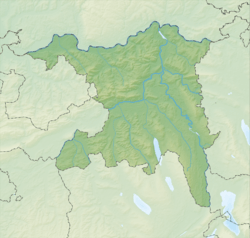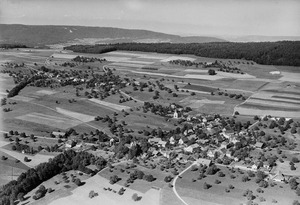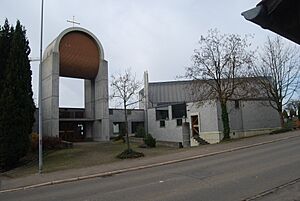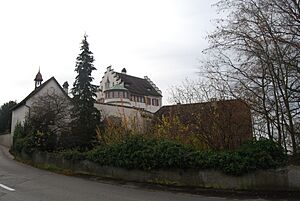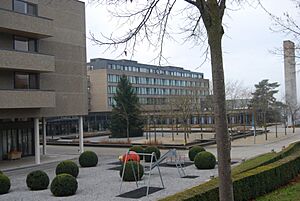Bellikon facts for kids
Quick facts for kids
Bellikon
|
||
|---|---|---|
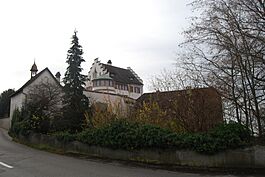 |
||
|
||
| Country | Switzerland | |
| Canton | Aargau | |
| District | Baden | |
| Area | ||
| • Total | 4.94 km2 (1.91 sq mi) | |
| Elevation | 597 m (1,959 ft) | |
| Population
(Dec 2020 )
|
||
| • Total | 1,544 | |
| • Density | 312.6/km2 (809.5/sq mi) | |
| Postal code |
5454
|
|
| Surrounded by | Bergdietikon, Eggenwil, Künten, Remetschwil, Spreitenbach, Widen | |
Bellikon is a small town, also called a municipality, in Switzerland. It is located in the canton of Aargau, within the Baden district.
Contents
History of Bellikon
Bellikon has a long history, going all the way back to Roman times. A Roman road, used for travel and trade, once passed through this area. This road connected Vindonissa (today's Windisch) and Turicum (which is now Zürich).
Ancient Discoveries
In 1934, people found old bricks in Bellikon. These bricks turned out to be from a Roman villa, a large country house. This villa was carefully dug up and studied in 1941. After that, it was covered up again to protect it. Things found at the site show the villa was built around the end of the 1st century.
Later, in the middle of the 6th century, a group of people called the Alamanni settled here. They cleared away the forests and, in doing so, destroyed the old Roman settlement.
Early Records and Changes
Bellikon was first officially mentioned on October 11, 1064. This was in a special document for Muri Abbey. However, the town was first named individually in the 12th century as Pellikon.
At first, Bellikon and Hausen paid a special tax, called a tithe, to Murbach Abbey. Later, the area became part of the lands controlled by the Habsburg family. In 1415, the Aargau region was taken over. After this, Bellikon became part of the village of Rohrdorf in the County of Baden.
Becoming Part of Switzerland
In 1798, Bellikon joined the Canton of Baden during the Helvetic Republic period. Then, in 1803, Bellikon and Hausen merged together. They became part of the Aargau Canton, which is where they are today.
Growth Over Time
At the start of the 20th century, Bellikon was mostly a farming village. It had about 377 people living there. Fifty years later, the population grew to 434. By the early 21st century, the number of people living in Bellikon had increased to over 1,400.
In 1974, a healthcare provider called SUVA opened a large facility here. In the same year, a new school was built for the children. The church, which was built in the 19th century, was replaced with a new, modern building in 1977.
Geography of Bellikon
Bellikon covers an area of about 5 square kilometers (about 1.9 square miles). A large part of this land, about 61.4%, is used for farming. Forests cover about 29.3% of the area. The remaining 9.3% of the land is where buildings and roads are located.
Bellikon is situated on the southwest side of a hill called the Heitersberg. It is separated from the Reuss and Limmat valleys. The municipality includes two main villages: Bellikon and Hausen.
People of Bellikon
As of the latest count, Bellikon has a population of about 1,700 people. About 11.4% of the people living here are from other countries. Over the last 10 years, the number of people in Bellikon has grown by about 17.5%.
Languages Spoken
Most people in Bellikon speak German, about 94.3% of the population. The second most common language is Serbo-Croatian, spoken by about 1.1% of residents. Italian is the third most common, spoken by about 0.8%.
Age Groups
The population of Bellikon includes people of all ages. About 10.1% of the population are children aged 0 to 9 years old. Teenagers, aged 10 to 19, make up about 11.1%.
Adults aged 20 to 29 are about 9.9% of the population. Those between 30 and 39 are about 12.2%. The largest group is people aged 40 to 49, making up about 21.9%. People aged 50 to 59 are about 16.4%.
Older adults, aged 60 to 69, are about 11.6% of the population. Those between 70 and 79 are about 5.1%. A small number of people, about 1.4%, are between 80 and 89. And about 0.3% are 90 years old or older.
Homes and Households
In Bellikon, there are many different types of homes. About 59 homes have only 1 or 2 people living in them. There are 216 homes with 3 or 4 people. And 238 homes have 5 or more people living together. On average, there are about 2.43 people in each household.
In 2008, there were 328 single-family homes in Bellikon. This was about 44.3% of all the homes and apartments in the municipality.
Education in Bellikon
People in Switzerland are generally well-educated. In Bellikon, about 87.8% of adults (aged 25 to 64) have finished either high school or gone on to higher education, like university.
For school-aged children, there are 120 students attending primary school in Bellikon. The nearest secondary school is in Oberrohrdorf. For even higher education, the nearest Kantonsschule (a type of high school that prepares students for university) are in Baden and Wettingen.
The population of Bellikon has changed over the years:
| Historical population | ||
|---|---|---|
| Year | Pop. | ±% |
| 1850 | 440 | — |
| 1900 | 377 | −14.3% |
| 1950 | 434 | +15.1% |
| 2000 | 1,303 | +200.2% |
| 2003 | 1,436 | +10.2% |
Religion in Bellikon
Based on a census from 2000, about 49.3% of the people in Bellikon are Roman Catholic. About 29.2% belong to the Swiss Reformed Church. There is also 1 person who belongs to the Christian Catholic faith.
Coat of Arms
The coat of arms for Bellikon shows a blue shield with a white castle. The castle has a stepped roof and a round tower on the left side.
Historically, in 1548, the village was mistakenly given the coat of arms of another family. But since 1827, the community has used arms that show Schloss Bellikon, which is Bellikon Castle. The design we see today was officially set in 1965.
Places to See
- Schloss Bellikon (Bellikon Castle) is a small castle that is featured on the town's coat of arms. It was built in the 13th century by the Habsburg family and was once known as Rotten Hus. From 1314 to 1640, a wealthy family from Zürich, the Krieg family, owned the castle. It has been sold a few times since then, most recently in 1999.
How Bellikon is Run
The people who live in Bellikon and are old enough to vote have the power to make laws for the community. This is done through a "community meeting." The daily work of running the town is handled by the local council. Members of the council serve for four years. They lead the municipality and make sure the decisions made at the community meeting are carried out. They also handle tasks given to them by the canton and the Swiss government.
Economy of Bellikon
The biggest business in Bellikon is the Suva clinic. This is a rehabilitation hospital that helps people recover from injuries or illnesses. It has over 200 beds for patients.
There are not many large businesses in Bellikon; most are small. Many people who live in Bellikon work in bigger nearby cities like Baden and Zürich.
In 2007, the unemployment rate in Bellikon was very low, at 1.49%. In 2005, about 37 people worked in farming. There were about 13 businesses in this area. About 23 people worked in manufacturing or construction, with 9 businesses in these fields. The largest number of people, 496, worked in services (like healthcare, shops, or offices), with 34 businesses in this sector.
Many residents of Bellikon travel outside the municipality for work. In 2000, about 76.6% of the people who lived in Bellikon worked in other towns. However, 321 people also traveled into Bellikon for their jobs. In total, there were 501 jobs available in Bellikon that year.
Bellikon has a kindergarten and a primary school for younger students.
Transportation
The busiest road in Bellikon connects Baden to the Mutschellen pass. There are also public bus services available, called Post bus services. The closest train station is Berikon-Widen, which is on the Bremgarten-Dietikon-Bahn line.
See also
 In Spanish: Bellikon para niños
In Spanish: Bellikon para niños




